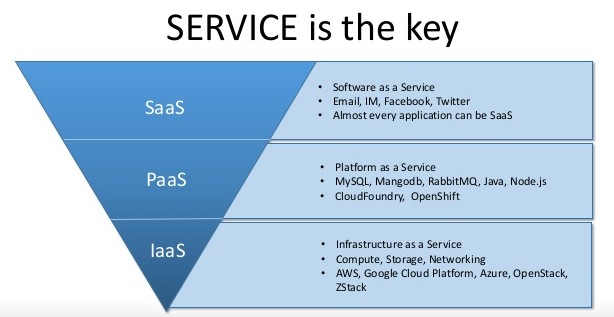IaaS, SaaS, PaaS - Three main categories of cloud computing services!
- IaaS: Infrastructure as a Service.
- SaaS: Software as a Service.
- PaaS: Platform as a Service.
These are the three delivery methods that we talk about when considering how to deliver, leverage, or purchase IT Services. When you are considering a software or technology solution to address some business need, you have choices. Do I buy it from some online service? Do I build it myself? Do I host the purchased software on my own servers and in my own datacenter, or do we rent space at another location? Who owns the server? Who owns the operating system? Who is responsible for securing our information? Who let the dogs out?
Infrastructure as a Service (IaaS) :
In an IaaS model, a third-party provider hosts hardware, software, servers, storage and other infrastructure components on behalf of its users. IaaS providers also host users’ applications and handle tasks including system maintenance, backup and resiliency planning.
IaaS platforms offer highly scalable resources that can be adjusted on-demand. This makes IaaS well-suited for workloads that are temporary, experimental or change unexpectedly. Other characteristics of IaaS environments include the automation of administrative tasks, dynamic scaling, desktop virtualization and policy-based services.
IaaS customers pay on a per-use basis, typically by the hour, week or month. Some providers also charge customers based on the amount of virtual machine space they use. This pay-as-you-go model eliminates the capital expense of deploying in-house hardware and software. However, users should monitor their IaaS environments closely to avoid being charged for unauthorized services.
Compared to SaaS and PaaS, IaaS users are responsible for managing applications, data, runtime, middleware, and OSes. Providers still manage virtualization, servers, hard drives, storage, and networking. Many IaaS providers now offer databases, messaging queues, and other services above the virtualization layer as well.
Leading IaaS providers: Amazon Web Services (AWS), Windows Azure, Google Compute Engine, Rackspace Open Cloud, and IBM SmartCloud Enterprise.
Software as a Service (SaaS) :
Software as a service (SaaS) is a software distribution model in which a third-party provider hosts applications and makes them available to customers over the Internet.
SaaS removes the need for organizations to install and run applications on their own computers or in their own data centers. This eliminates the expense of hardware acquisition, provisioning and maintenance, as well as software licensing, installation and support.
Most SaaS applications can be run directly from a web browser without any downloads or installations required, although some require plugins.
Because of the web delivery model, SaaS eliminates the need to install and run applications on individual computers. With SaaS, it’s easy for enterprises to streamline their maintenance and support, because everything can be managed by vendors: applications, runtime, data, middleware, OSes, virtualization, servers, storage and networking.
Popular SaaS offering types include email and collaboration, customer relationship management, and healthcare-related applications. Some large enterprises that are not traditionally thought of as software vendors have started building SaaS as an additional source of revenue in order to gain a competitive advantage.
SaaS Examples: Google Apps, Salesforce, Workday, Concur, Citrix GoToMeeting, Cisco WebEx
Common SaaS Use-Case: Replaces traditional on-device software.
Platform as a service (PaaS) :
Platform as a service (PaaS) is a cloud computing model that delivers applications over the Internet. In a PaaS model, a cloud provider delivers hardware and software tools – usually those needed for application development – to its users as a service. A PaaS provider hosts the hardware and software on its own infrastructure. As a result, PaaS frees users from having to install in-house hardware and software to develop or run a new application.
PaaS does not typically replace a business’ entire infrastructure. Instead, a business relies on PaaS providers for key services, such as Java development or application hosting. For example, deploying a typical business tool locally might require an IT team to buy and install hardware, operating systems, middleware (such as databases, Web servers and so on) the actual application, define user access or security, and then add the application to existing systems management or application performance monitoring (APM) tools. IT teams must then maintain all of these resources over time. A PaaS provider, however, supports all the underlying computing and software; users only need to log in and start using the platform – usually through a Web browser interface.
Most PaaS platforms are geared toward software development, and they offer developers several advantages. For example, PaaS allows developers to frequently change or upgrade operating system features. It also helps development teams collaborate on projects.
Enterprise PaaS Examples: ClodFoundry, OpenShift.
